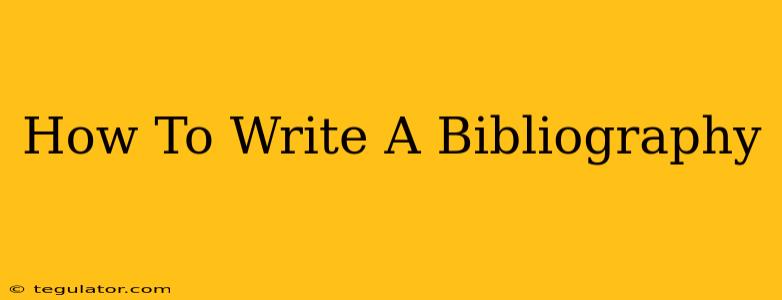Creating a bibliography might seem daunting, but it's a crucial skill for academic and professional writing. A well-crafted bibliography demonstrates your research integrity and allows readers to easily verify your sources. This guide breaks down the process step-by-step, covering different citation styles and offering helpful tips for success.
Understanding What a Bibliography Is
A bibliography is a list of all the sources you consulted during your research, regardless of whether you cited them directly in your text. It provides a comprehensive overview of the materials that informed your work. This differs from a Works Cited page or References list, which only includes sources explicitly mentioned in your writing.
Think of it as your research journey documented – a complete record of everything you explored to support your arguments and conclusions.
Choosing the Right Citation Style
The most important decision is selecting the appropriate citation style. Different academic disciplines and publications prefer specific styles. Some of the most common include:
- MLA (Modern Language Association): Widely used in humanities disciplines like literature, languages, and cultural studies.
- APA (American Psychological Association): Predominant in social sciences, psychology, and education.
- Chicago/Turabian: Offers both a notes-bibliography style and an author-date style, frequently used in history and other humanities fields.
- IEEE (Institute of Electrical and Electronics Engineers): Standard for engineering, computer science, and related fields.
Your instructor or publication guidelines will specify the required style. Familiarize yourself with the style's specific rules before you begin.
Key Components of a Bibliography Entry
Regardless of the style you choose, a typical bibliography entry includes these essential elements:
- Author: The person or organization responsible for the work. If there are multiple authors, list them in the order specified by your style guide.
- Title: The title of the book, article, website, or other source. Follow capitalization rules specified by your style guide.
- Publication Information: This varies depending on the source type. For books, it includes the publisher, place of publication, and year. For articles, it includes the journal name, volume number, issue number, pages, and publication date. For websites, it includes the URL and access date.
Step-by-Step Guide to Creating Your Bibliography
-
Gather Your Sources: Compile a list of every source you consulted, including books, articles, websites, interviews, and any other relevant materials. Keep track of the source information as you go.
-
Choose Your Citation Style: Confirm the required style guide and obtain a copy of the style manual or access a reliable online guide.
-
Create Individual Entries: For each source, carefully create a bibliography entry following the specific formatting rules of your chosen style guide. Pay close attention to details like punctuation, capitalization, and order of information. Many word processors offer citation management tools (like Zotero or Mendeley) that can automate this process.
-
Alphabetize Entries: Arrange your bibliography entries alphabetically by the first author's last name (or by title if there is no author).
-
Proofread Carefully: Check for any errors in formatting, spelling, punctuation, or capitalization. A well-formatted bibliography enhances the credibility of your work.
-
Create a Title: Use a clear and concise title such as "Bibliography," "Works Consulted," or "References" as appropriate.
Tips for Success
-
Use a Citation Management Tool: Tools like Zotero, Mendeley, and EndNote can save you significant time and effort by automatically formatting citations and creating bibliographies.
-
Consult Style Manuals: Don't rely solely on online resources. Having a printed style manual handy will help you navigate the nuances of specific formatting rules.
-
Double-Check Your Work: Errors in your bibliography can undermine the credibility of your research. Take the time to thoroughly proofread your bibliography before submitting your work.
By following these steps and utilizing helpful resources, you can confidently create a comprehensive and accurate bibliography for any project. Remember, a well-organized bibliography is a testament to your meticulous research and scholarly integrity.

